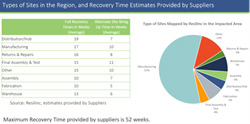Supply Chain Experts Warn that Impact of Hurricane Harvey will be Worse than Expected

Site Concentrations in affected Areas
This is going to be a big supply chain disruption. Resilinc has mapped almost 800 factories, warehouses, distribution centers etc. to the region of Texas that was affected by Hurricane Harvey, and 300 of them are in the Houston vicinity
(PRWEB) September 01, 2017
Two of the world’s foremost experts on supply chain risk management, predicted that the global supply chain impact of Hurricane Harvey will be unprecedented, widespread and realized, not only in the near term, but in weeks and months to come. Bindiya Vakil, CEO and founder of Resilinc and Joe Carson, Chief Strategy Officer at Resilinc warn the supply chain leadership of companies that Hurricane Harvey’s disruptions will ripple through the supply chain and be realized at factories and facilities far away from the impacted area.
“Let’s not kid ourselves folks, this is going to be a big supply chain disruption. Resilinc has mapped almost 800 factories, warehouses, distribution centers etc. to the region of Texas that was affected by Hurricane Harvey, and 300 of them are in the Houston vicinity,” warned Ms. Vakil. “Even if a supplier’s factory is not flooded, the infrastructure (power, water, transportation etc.), needed to operate is not going to be there for weeks”.
The experts cited several key points to make the case for why this would be a major supply chain disruption. First, Hurricane Harvey, which formed on August 24 as a Tropical Storm in the Gulf of Mexico, soon strengthened into a massive Category 4 Hurricane and stalled over a commercially vital region of Texas dumping record levels of rain, as much as 52 inches in some regions, causing widespread and extensive flooding in the Houston and surrounding low-lying areas. This region of Texas is responsible for almost $600 billion in economic activity and is home to ports that trade with many countries around the world.
Second, Texas’ chemical industry is a foundational block of the interconnected global supply chain. Resilinc’s extensive data repository, which tracks millions of parts and raw materials through multiple supply chain tiers by mapping the global supply chain connections, shows that 68 key chemicals and intermediates originate from the Texas region. Every product we use or manufacture today, relies in some way, on these chemicals and chemical intermediates. These chemicals, polymers, resins and raw materials may not only be in the direct supply chain but are certainly present in the suppliers’ supply chains.
Third, the data provided by the tens of thousands of suppliers in the Resilinc platform indicates that in a worst-case scenario such as this, average recovery times are 10-20 weeks, with the maximum time to resume full pre-production volumes being as long as 52 weeks. “If the roads leading up to the factory are damaged, that is a 2-4 week disruption, but if the factory is flooded, then equipment procurement or repair time, setup and qualification time, production lead time and transit times, all become critical path to recovery,” said Ms. Vakil. “The closer you are to the suppliers in the region, the sooner the disruption will hit your supply chain. If these suppliers are in your sub-tier supply chain, and if you have not mapped your supply chain dependencies, the capacity and material constraints will be realized in the weeks to come.”
“We recommend you not take a wait and see approach, but activate your Disruption Event Response teams. Get your internal stakeholders and partners together, work closely with suppliers, verify supplier impact assessments and prepare for a months’ long recovery effort that spans multiple supply chain tiers,” said Mr. Carson. “Second sources may also be overwhelmed with business and shifting customer priorities. First-movers, who know all their supply options and obstacles, and who can work with speed and precision will get parts that their competitors and those in other industries will miss out on.” Carson continues, “I would also remember that suppliers who are not located in the affected area could be relying on materials that come from this region – knowingly or unknowingly due to the supplier being many tiers downstream - and therefore could get disrupted in the coming days or weeks.”
“The reality is that many companies have been lagging in adequately investing in risk and resiliency technologies, processes and tools, and are woefully manual and highly inefficient in their procurement and supply chain organizations, relying heavily on people and Microsoft Excel tools,” said Ms. Vakil. “We are concerned that suppliers may not have invested in the necessary capabilities such as multi-tier supply chain visibility/mapping, proactive risk mitigation, and 24x7 monitoring and disruption response planning. Our assessment is that suppliers’ risk management capabilities are not mature enough, and therefore, we suggest companies verify extensively when suppliers state that impact is expected to be 1-4 weeks long.”
The complete webinar can be viewed here http://info.resilinc.com/Hurricane-Harvey-webinar
About Resilinc
Resilinc is the trusted provider of supply chain risk and resiliency solutions. Resilinc provides a patented, digital, automated and networked platform to allow customers to collaborate seamlessly with their direct and sub-tier suppliers. With over 2 million parts tracked across 85,000 global sites and more than 70,000 sub-tier connections, Resilinc has digitized the supply chain experience. Resilinc’s approval-based mapping solution enables customers and suppliers to exchange supply chain intelligence with each other securely, and accelerates the supply chain visibility journey, from years to weeks at a fraction of the cost. Resilinc EventWatch 24x7 solution monitors 30 different risk events in 44 languages and collects impact confirmations in real time from tens of thousands of users during an event, allowing customers to engage and resolve issues efficiently and with precision
---
Other websites of interest:
